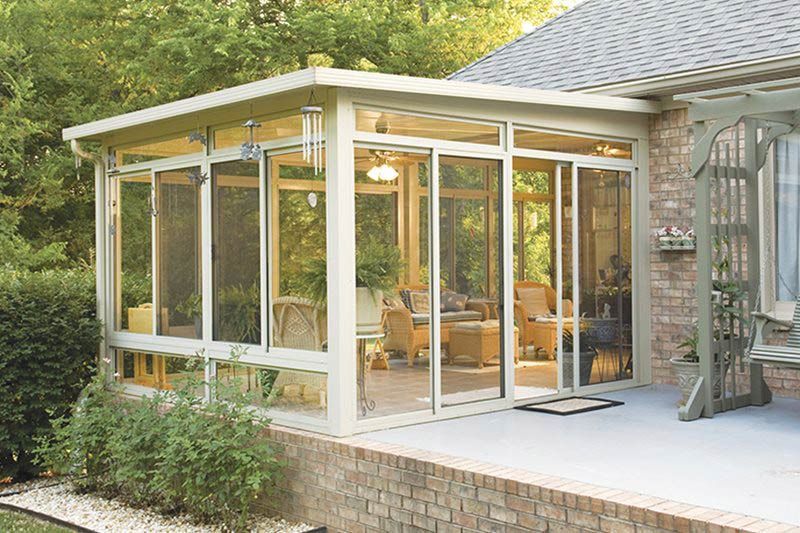Keeping your sunroom warm throughout the year is a priority for most. Sunrooms benefit from warm solar gain throughout the warmer months, but from November through March, you might need a little help to keep cold air from getting in. Sunroom insulation doesn’t just benefit you by keeping you cozy; it also makes the room more energy-efficient and should save you money on energy bills. Insulation is one of the best energy-efficient methods because it’s affordable and straightforward.
Insulating a sunroom is a two-step process — you need to insulate the ceiling and wall space, then circulate warm air throughout the structure.
What Is a Sunroom?
Sunrooms are usually attached to the area of your home that sees the most day sun exposure (ideally directly south-facing) and are entirely made of single-pane glass. This gives you an extra living space that crosses the boundary between indoors and outdoors, allowing you to enjoy the view of the yard without worrying about wind, debris or small critters.
A sunroom is usually a three-season room that doesn’t have an HVAC system attached, so it’s not necessarily designed for year-round use. However, with proper insulation to prevent heat loss, you can use your existing sunroom as a sitting room while promoting energy efficiency. Sunrooms are usually a little more affordable than a full addition such as an extension, and if you’re smart, you can enjoy them without letting that precious solar energy escape.
Sunroom vs. Screenroom — What to decide?!
PWHI is the leading Screenroom installer in Maryland & Virginia
Keeping your sunroom warm throughout the year is a priority for most. Sunrooms benefit from warm solar gain throughout the warmer months, but from November through March, you might need a little help to keep cold air from getting in. Sunroom insulation doesn’t just benefit you by keeping you cozy; it also makes the room more energy-efficient and should save you money on energy bills. Insulation is one of the best energy-efficient methods because it’s affordable and straightforward.
Insulating a sunroom is a two-step process — you need to insulate the ceiling and wall space, then circulate warm air throughout the structure.

What Is a Sunroom?
Sunrooms are usually attached to the area of your home that sees the most day sun exposure (ideally directly south-facing) and are entirely made of single-pane glass. This gives you an extra living space that crosses the boundary between indoors and outdoors, allowing you to enjoy the view of the yard without worrying about wind, debris or small critters.
A sunroom is usually a three-season room that doesn’t have an HVAC system attached, so it’s not necessarily designed for year-round use. However, with proper insulation to prevent heat loss, you can use your existing sunroom as a sitting room while promoting energy efficiency. Sunrooms are usually a little more affordable than a full addition such as an extension, and if you’re smart, you can enjoy them without letting that precious solar energy escape.
Why Keep a Sunroom at a Comfortable Temperature Year-Round?
Insulating existing windows in your sunroom means you can prevent air from escaping, which helps you keep it warm during winter. What’s more, insulation protects your sunroom from sun exposure during summer, which helps keep it cooler and prevents overheating. A bonus benefit of weatherizing your sunroom windows and ceiling is the cash you save on your energy bills.
Heat Rises: Start With the Sunroom Ceiling
Your sunroom’s roof is the part that’s exposed to the most solar radiation, so it’s the main area the sun hits during summer. However, heat rises, so it’s also most at risk for solar energy escape during colder months. As such, insulating the sunroom roof is one of the most effective and smartest ways to weatherize your three-season room and keep heating and cooling bills in check.
Ceiling Blinds
While some people might not like the appearance of ceiling blinds, they act as a small defense against cool air in winter and prevent too much heat getting in during summer. It’s possible to purchase blinds that have a reflective coating on one side to reflect light and prevent heat from building up. Provided they’re the correct size and the color is in keeping with your decor, they can look attractive.
Solid Insulation
Depending on the type of roof you have, you might be able to install solid insulation sheets or rigid foam between the rafters. You can cut these down to the perfect size and install them yourself, providing some insulation for minimal cost and effort. However, these boards can be heavy and awkward to install and might not suit your sunroom’s aesthetic.
Spray Foam Insulation
Spray foam expands from its original size and adheres well to most materials, so it’s suitable for ceilings and unlikely to fall down or collapse. This type of material is completely waterproof, and the extra layer can help to add structural integrity to your sunroom roof.
Mineral Wool
While it might not appeal to everyone, if your priority is energy efficiency and you don’t mind covering your roof fully, mineral wool is an excellent insulation material. You might also lose a little headroom with mineral wool, and it’s not compatible with all lights, but it can certainly keep heat inside in winter.

Step-by-Step Guide to Full Sunroom Insulation
Now that you’ve covered the roof using one or more of the above methods, let’s take care of the rest of the sunroom. Here’s a step-by-step guide on how to insulate a sunroom properly.
1. Add Weather Stripping
Stop warm air from escaping through the window frames by using weather stripping or clear caulk. You can seal the area between the wall and the window frame or between two butting window frames.
2. Apply Window Tinting
Window tinting is a smart way of allowing solar energy to warm your space without letting any escape. It usually doesn’t obscure the view much but can help with privacy if your sunroom is located near neighbors.
3. Use Fiberglass Insulation Sheets
Fiberglass insulation sheets are a great way to stop air from escaping or getting into your sunroom. Fiberglass doesn’t have the same R-value as a more robust material, but it can still improve the efficiency of single-pane glass.
4. Install a Ceiling Fan
Ceiling fans might seem counterintuitive because they can’t heat your sunroom in winter, but they can help by recirculating warm air that’s risen to the ceiling back down to the livable part of your sunroom.
5. Hang Insulated Drapes
Heavy drapes or curtains made from insulated material help keep cold air out and warm air inside. Open them during the day to take advantage of the radiant heat, then close them at sunset to trap it inside.
6. Think About the Floor
The flooring material you choose can have an impact on insulation and the energy efficiency of your sunroom. Opt for underfloor heating for a clean, efficient way of warming your sunroom, or consider carpets if a heated floor is beyond your budget. The material traps heat and keeps the entire room warmer during winter.
7. Finish With a Space Heater or Electric Fireplace
Another way to heat your sunroom is by installing a fireplace or buying a space heater or another type of stand-alone heater. With the rest of the structure fully insulated, you have a wide range of options for heating the sunroom with peace of mind that warm air won’t escape.
Save Energy and Insulate Your New Sunroom
If you’re looking to install a new sunroom but want to make sure it’s not going to negatively impact energy usage, let Prince William Home Improvement take care of installation. Call us today at 703-492-1294 to get started.

